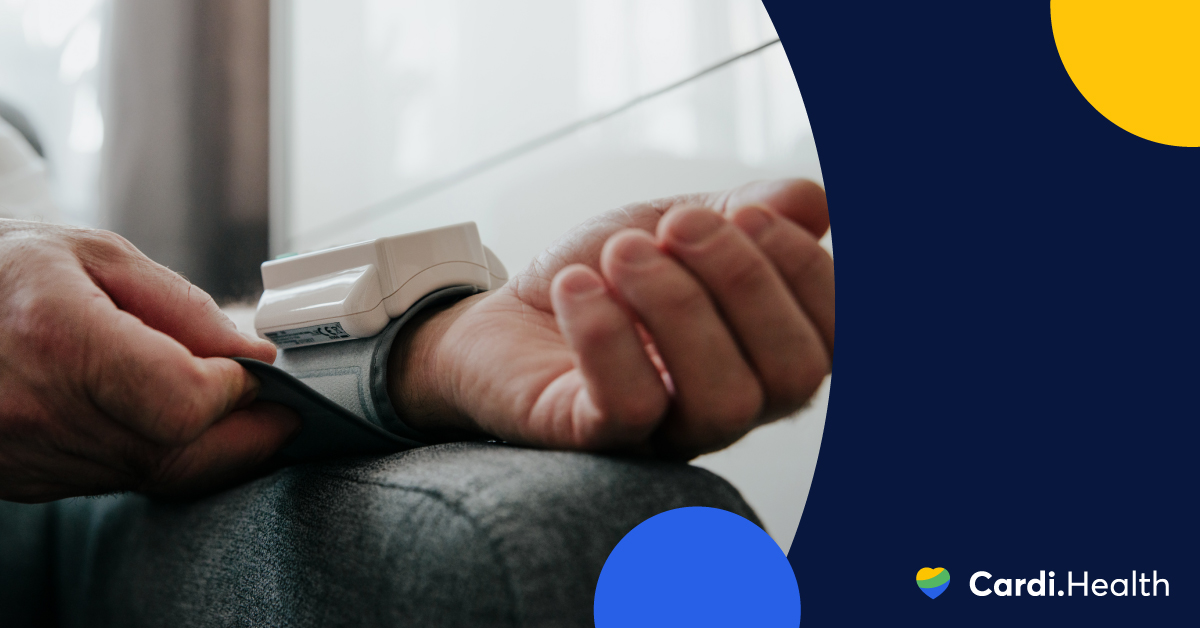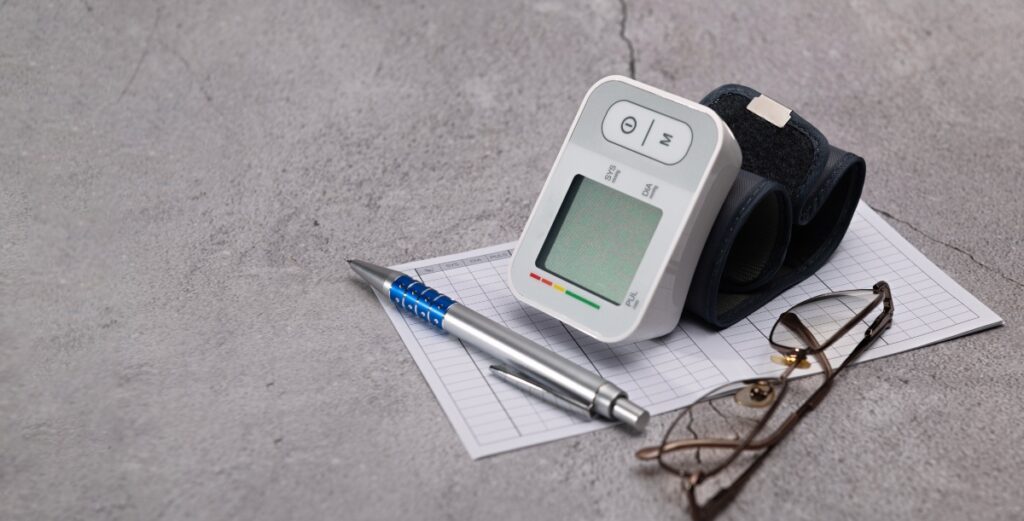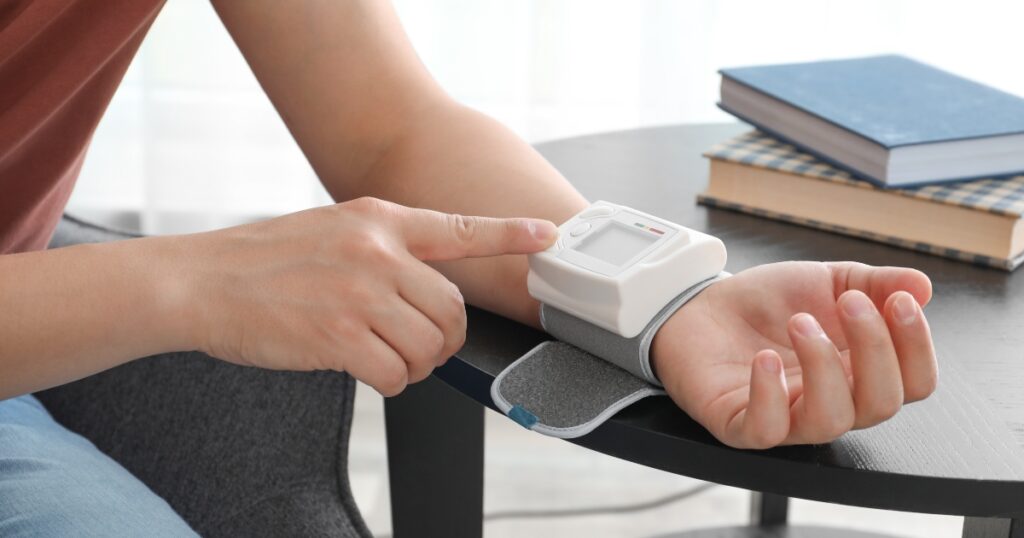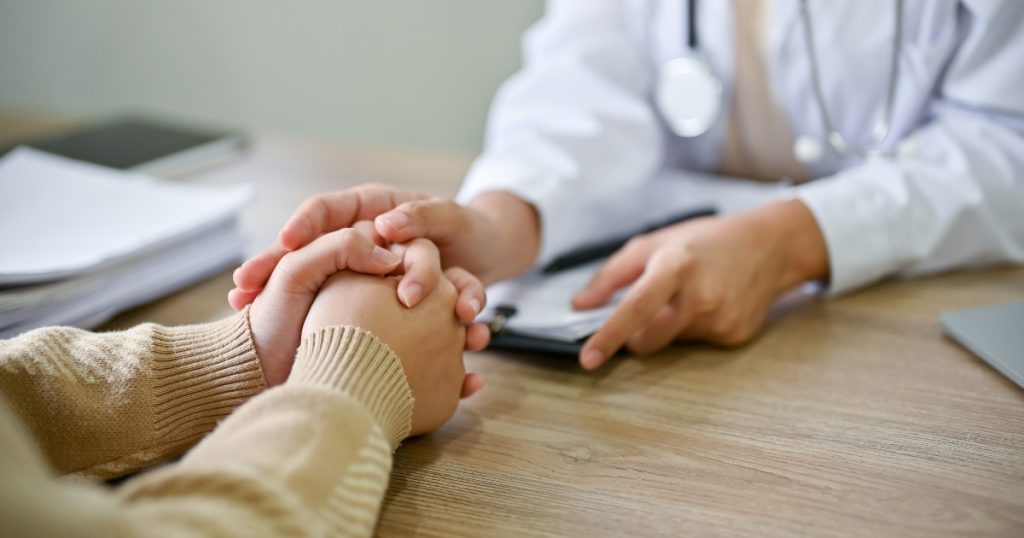How to Take Blood Pressure With Wrist Cuff: Comprehensive Guide
You might have heard concerns over the accuracy of using a wrist blood pressure monitor, but by observing the right precautions, like wearing it correctly and positioning yourself properly, this device can be quite accurate.
This article will talk about using wrist blood pressure monitors, wearing them properly, and how to understand the readings that they give. Let’s get into it.

Master your heart health now
Take part in our 60sec quiz and get a heart health plan tailored just for you.
Contents
Choosing and Using a Wrist Blood Pressure Monitor
The average blood pressure monitor has a cuff worn around the upper arm that measures pressure from the brachial artery. Wrist blood pressure monitors are strapped on your wrist instead.
Wrist blood pressure monitors are similar to upper arm monitors in almost all ways apart from where they are worn. A wrist BP monitor may be more compact, and there are specific situations where wrist monitors are a better choice:
- People with large upper arms who can’t get a suitable cuff
- People who have had armpit lymph nodes removed
- Painful or inaccessible upper arm, like fractures or dislocations
- Arthritis of the elbows or shoulders that makes proper positioning difficult

If you’re looking to get a wrist blood pressure monitor, you’ll want to ensure you get a suitable device. Take these into consideration:
- Accuracy: Try to get a blood pressure monitor that is on the US Blood Pressure Validated Device Listing. This shows it meets the standards of the American Medical Association.
- Comfort: If possible, try to buy wrist blood pressure monitors in person. This way, you can try it on the wrist. It shouldn’t slip around but also shouldn’t pinch. Adjustable straps can help.
- Price: A wrist blood pressure monitor that gives accurate measurements, such as from Omron, will cost a bit more than others. Try to get the best monitor within your budget.
- Connectivity: BP monitors that allow you to connect to an app on your phone can make it easier to keep track of your readings over time.
Start managing your heart health now!
Find out what works for you with this 60sec quiz.

Preparing for Blood Pressure Measurement
When you take a blood pressure measurement, being in a suitable environment and adopting the proper position will make an accurate reading more likely.
Having your body or limbs in certain positions can affect how blood flows through your body and can give inaccurate readings.
Take your blood pressure measurement in a quiet, calm environment. Have a comfortable chair with a sturdy back that lets you easily have your feet flat on the floor.
Also, get a flat surface to rest your arm on during the reading. Your elbow should be on the surface, with your forearm bent so that the monitor is against your chest at heart level.
Taking Blood Pressure Measurements With a Wrist Cuff

If you’re unfamiliar with wrist blood pressure monitors, here’s how to take your blood pressure at home and accurately. Follow the steps below:
- Wearing the cuff: First, wear the cuff properly. Have the part with the screen facing the same side as your palm. Fasten it tightly, but it shouldn’t pinch. The top edge of the cuff should align with your wrist’s crease.
- Starting the wrist blood pressure monitor: You can press the “Start” or “On” button at this point. Before the reading automatically starts, handle the next step.
- Positioning your upper limb properly: Have your elbow on a surface, bending it so that your wrist is against your chest at heart level (around your nipple line). Avoid having your arm flat in front of you or above your heart.
- Taking the reading: After pressing the Start button, you should feel your wrist blood pressure monitor begin to inflate. Make sure you keep your arm and body still until it is done.
- Noting the measurements: Record the blood pressure numbers in your notebook or mobile app.
Interpreting Blood Pressure Readings and Understanding Normal Ranges
If you have high blood pressure, you have to know how to interpret the readings.
These blood pressure numbers can make it possible for you to find out whether you have a high BP. The stress that high blood pressure can put on your heart and blood vessels can predispose you to many cardiovascular diseases.
Below are different categories of blood pressure and the corresponding systolic and diastolic values, respectively:
- Normal blood pressure: <120 and <80mmHg
- Prehypertension: 120–129 and <80mmHg
- Hypertension Stage 1: 130–139 or 80–89mmHg
- Hypertension Stage 2: >140 or >90mmHg
- Hypertensive Crisis: >180 and/or >120mmHg
Tips for Accurate Blood Pressure Monitoring

If you’re going to be measuring your blood pressure at home, there are some tips you can follow to keep things as accurate as possible.
Maintaining consistency in measurement
It is important that you use your wrist blood pressure monitor regularly and keep records of your blood pressure measurements. Tracking blood pressure can let you see how it responds to medication and find things that might be causing spikes and crashes.
Aim to monitor your blood pressure at the same time every day.
The Cardi Health app can make this easy, as you can log your wrist blood pressure monitor readings into the app, keep records over several months, and even get reminders to check your BP.
Minimize external factors that may affect blood pressure readings
If you’re going to be taking home blood pressure regularly, it is very important that you know the things that can temporarily alter your blood pressure and give you a measurement that isn’t accurate.
- Exercise: Exercise causes an acute increase in BP. Avoid monitoring your blood pressure immediately after working out, or wait about an hour or two after.
- Caffeine: Caffeine, commonly found in coffee, energy drinks, and soda, can acutely increase blood pressure, so avoid it before home blood pressure measurement. The American Heart Association recommends cutting down your intake, as it can increase the risk of dying from cardiovascular disease.
- Smoking: Smoking is well-documented to cause an acute rise in blood pressure, so avoid smoking before you monitor your BP.
- Stress: Stress from work, school, or life can increase BP and can cause hypertension. Tapping into stress management techniques can help with this.
Start managing your heart health now!
Find out what works for you with this 60sec quiz.

Resting a few minutes before the measurement
It is very important to get some minutes of rest before taking a blood pressure measurement. It is recommended that you sit quietly for about 3–5 minutes before you measure, as this can let your blood flow and heart rate “settle.”
However, a study by the American Heart Association showed that as little as 2 minutes can be sufficient for accurate monitoring of BP.
What Is Blood Pressure, and Why Is It Important?
Blood pressure monitors will show you two figures. The first is the systolic blood pressure, which is the pressure when the heart is contracting. The second is diastolic blood pressure, which is when the heart is relaxed.
In hypertension, the high pressure puts stress on the blood vessels. Over time, this can weaken the vessel walls, leading to leaks or plaque buildup and eventually strokes, heart attacks, and other cardiovascular problems.
This is why accurate monitoring is essential in hypertension. It gives your doctor the right values for diagnosis and treatment.
When you use a wrist blood pressure device, you should also record your values and make lifestyle modifications that can help you manage your hypertension. The Cardi Health app is a convenient way to record the numbers you measure and can also provide personalized recommendations to manage hypertension.
When to Consult a Healthcare Provider

Hypertension, at its worst, can lead to complications that severely impact your quality of life or even cause death.
This is why it is important to go to your doctor’s office at regular intervals. A diagnosis could be made coincidentally, and for people who are already treating hypertension, it makes it possible to stay on top of any changes in blood pressure in terms of management.
Keep in mind that blood pressures in the hypertensive crisis range are a medical emergency, and you should contact medical services as soon as possible.
Start managing your heart health now!
Find out what works for you with this 60sec quiz.

FAQ
What are the systolic and diastolic blood pressure readings?
Systolic blood pressure is the pressure when the heart is contracting, while diastolic blood pressure is when the heart is relaxed.
Why is accurate blood pressure monitoring essential?
Accurate monitoring helps diagnose and treat hypertension, which, if unchecked, can weaken blood vessels, leading to strokes, heart attacks, and other cardiovascular problems.
How can the Cardi Health app assist in managing hypertension?
The Cardi Health app allows you to log your blood pressure monitor readings, maintain records over time, get reminders to check your BP, and the app provides personalized recommendations for managing hypertension.
When should I consult with a healthcare provider about my blood pressure readings?
Regular check-ups with a doctor are essential for diagnosis and treatment adjustments. If your blood pressure readings fall in the hypertensive crisis range, it’s crucial to contact medical services immediately.
Key Takeaways
If you use a wrist cuff instead of an upper arm blood pressure monitor, you should aim to get a validated device and one that fits on your wrist comfortably.
Wear the device on your wrist, ensuring it is not too tight, keep the monitor at heart level with your elbow on a stable surface, and start the measurement. Using a wrist blood pressure device is simple.
Whether you’re taking wrist or arm blood pressure measurements, it can be done in a few minutes. Make sure that you check regularly, stay consistent with medications, and make the right lifestyle modifications to keep your BP in check.
Related articles
Best Foods to Lower Cholesterol
Does Caffeine Raise Blood Pressure?
Does Drinking Water Lower Blood Pressure?
Causes of High Blood Pressure at Night
10 DASH Diet Breakfasts for a Healthy Start
Heart-Healthy Diet Guide
What Should an 85-Year-Old Blood Pressure Be?
What is Normal Blood Pressure for a 70-Year-Old?
How to Read Blood Pressure: A Comprehensive Guide
Manage your heart health now
Find out what works best for you with this 60sec quiz and get your personalized heart health plan.

